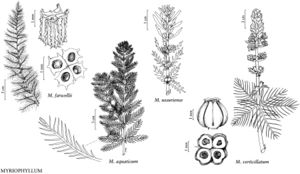Myriophyllum aquaticum
Kew Bull. 28: 36. 1973.
Herbs dioecious, pistillate, not staminate, in flora area, aquatic or semiaquatic, often forming dense stands. Stems branched or unbranched, to 5 m. Turions absent. Leaves in whorls of 4–6(–8), homomorphic; petiole to 9.6 mm; submersed leaves pectinate, oblanceolate to obovate in outline, (20–)25–70(–75) × (4–)5–26(–32) mm, segments (14–)16–36(–40), filiform, longest segment (2–)4–27(–33) mm; emersed leaves becoming unmodified floral bracts. Inflorescences to 20 cm; flowers unisexual; bracteoles cream to stramineous, (0.3–)0.5–1(–1.5) × 0.1–0.3(–0.5) mm, margins subulate to 3-fid. Staminate flowers: sepals cream, ovate to deltate, 0.7–0.8 ×0.3 mm; petals yellow, weakly cucullate, (2.3–)2.7–3.1 × 0.8–1.1 mm; stamens 8, filaments to 1.2 mm, anthers yellow, linear-oblong, (1.8–)2–2.7 × 0.2 mm. Pistillate flowers: sepals cream, lanceolate to deltate, 0.3–0.5 × 0.1–0.2(–0.4) mm; petals rudimentary or absent; pistils to 0.8 mm, stigmas white, to 0.3 mm. Fruits cylindric to ovoid, shallowly 4-lobed. Mericarps olive-green to brown, cylindric, 1.7 × 0.6–0.7 mm, narrowly obovate, abaxial surface rounded, ridges, wings and ribs absent.
Phenology: Flowering and fruiting Apr–Sep.
Habitat: Lakes, canals, bays, ponds, slow moving ditches, creeks, rivers.
Elevation: 0–1500 m.
Distribution
Introduced; B.C., Ala., Ariz., Ark., Calif., Conn., Del., D.C., Fla., Ga., Idaho, Ill., Ind., Kans., Ky., La., Md., Mass., Minn., Miss., Mo., N.J., N.Mex., N.Y., N.C., Ohio, Okla., Oreg., Pa., R.I., S.C., Tenn., Tex., Va., Wash., W.Va., Wis., South America, introduced also in Mexico, Central America, Eurasia, Africa, Indian Ocean Islands, Pacific Islands, Australia.
Discussion
In the flora area, Myriophyllum aquaticum is an introduced invasive aquatic species, existing as pistillate populations throughout North America (R. Couch and E. Nelson 1992); it is native to the lowlands of South America (A. E. Orchard 1981). It has an unusual habit among North American species of Myriophyllum, where it is often observed as a robust emergent aquatic along shorelines. It can be found also growing to a depth of 5 m in lakes, with the largest submersed leaves recorded for any North American species of Myriophyllum. The leaves of M. aquaticum are very distinctive, being largely oblanceolate and two to three times as long as broad, with a large number of uniform, short-pinnate segments, often arranged in whorls of six or more.
Myriophyllum aquaticum has been reported from Iowa and Montana; no specimens have been seen that confirm these reports.
Selected References
None.
